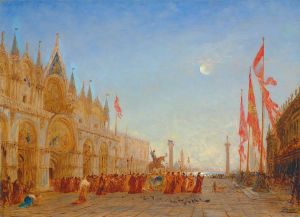
Tête d’homme, d’après Rembrandt
A hand-painted replica of Félix Ziem’s masterpiece Tête d’homme, d’après Rembrandt, meticulously crafted by professional artists to capture the true essence of the original. Each piece is created with museum-quality canvas and rare mineral pigments, carefully painted by experienced artists with delicate brushstrokes and rich, layered colors to perfectly recreate the texture of the original artwork. Unlike machine-printed reproductions, this hand-painted version brings the painting to life, infused with the artist’s emotions and skill in every stroke. Whether for personal collection or home decoration, it instantly elevates the artistic atmosphere of any space.
"Tête d’homme, d’après Rembrandt" is a painting by the French artist Félix Ziem. Ziem, born on February 26, 1821, in Beaune, France, was a notable painter associated with the Barbizon School and is best known for his landscape and maritime scenes. His works often reflect his extensive travels, particularly his visits to Venice, which became a recurring theme in his art.
The title "Tête d’homme, d’après Rembrandt" translates to "Head of a Man, after Rembrandt," indicating that this painting is a study or interpretation inspired by the works of the Dutch master Rembrandt van Rijn. Rembrandt, who lived from 1606 to 1669, is renowned for his portraits and his ability to capture the human condition with profound depth and realism. Ziem’s decision to create a work inspired by Rembrandt suggests a deep admiration for the Dutch artist’s technique and subject matter.
The painting itself features a detailed and expressive depiction of a man’s head, showcasing Ziem’s skill in portraiture and his ability to convey character and emotion through his brushwork. While Ziem is primarily celebrated for his landscapes, "Tête d’homme, d’après Rembrandt" highlights his versatility and his engagement with the broader European artistic tradition.
Félix Ziem’s career was marked by significant recognition. He exhibited regularly at the Paris Salon, and in 1857, he was awarded the prestigious Légion d'Honneur for his contributions to French art. His works were highly sought after during his lifetime, and he enjoyed considerable success both in France and internationally.
"Tête d’homme, d’après Rembrandt" is part of Ziem’s broader oeuvre, which includes a variety of subjects beyond his famous Venetian scenes. This painting exemplifies his ability to draw inspiration from other great artists while maintaining his unique style and perspective. Ziem’s work is characterized by its vibrant use of color, dynamic compositions, and a keen sense of atmosphere, all of which are evident in this particular piece.
The painting is an example of how 19th-century artists like Ziem engaged with the legacy of the Old Masters, studying their techniques and themes to enrich their own artistic practice. By referencing Rembrandt, Ziem not only pays homage to the Dutch painter but also situates himself within a lineage of European art that values technical mastery and emotional depth.
Today, Félix Ziem’s works, including "Tête d’homme, d’après Rembrandt," can be found in various museums and private collections around the world. His paintings continue to be appreciated for their beauty, technical skill, and the unique perspective they offer on the places and people he depicted. Ziem’s legacy as a painter who bridged the Romantic and Realist movements in 19th-century French art remains significant, and his works are studied and admired by art historians and enthusiasts alike.


















